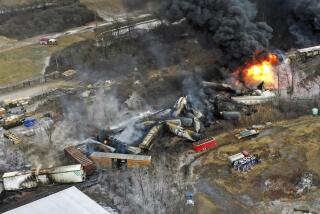Critical Safety Issues Overlooked at Nuclear Plant, 3 Professors Charge
PORTLAND, Ore. — Three university critics of nuclear power charged at a congressional hearing here Monday that critical safety issues at a government reactor in Washington state had been overlooked by authorities.
At the hearing, the Department of Energy, which owns the plant, rejected such criticism and repeated earlier assertions that its reactor on the Hanford nuclear reservation is safe. Also Monday, the department made public a new review of the Hanford reactor that concluded that the reactor’s graphite core is safe from fire and that its confinement system could retain any unexpected release of radioactivity.
The three professors who testified before the House Interior and Insular Affairs subcommittee here were Daniel Hirsch and W. Jackson Davis of the Stevenson Program on Nuclear Policy at the University of California at Santa Cruz and USC chemistry professor emeritus James C. Warf, who worked on the Manhattan Project that produced the first atomic bomb during World War II.
Similar to Chernobyl
The Hanford plant is the U.S. reactor most similar to the disaster-stricken Soviet Chernobyl plant. Like Chernobyl, the Hanford reactor has a graphite core and no containment dome. The Hanford facility produces about 20% of the nation’s plutonium for nuclear weapons as well as electricity for Northwest utilities.
Warf said his study of the plant led him to conclude that a Chernobyl-type accident remains “a distinct possibility” at Hanford.
Hirsch and Davis warned that in the event of a reactor emergency, highly radioactive cooling water could be dumped into the Columbia River, which is several hundred yards away, and contaminate the Columbia River Basin and the Pacific Ocean as far south as San Diego.
Contamination of the river could result if the primary cooling system for the reactor fails in an emergency, they said. Water from the backup emergency system would be flushed through the reactor core and into a catch basin. If the catch basin were to overflow, the water would be carried into a “crib,” or rock-lined hole in the ground just a few hundred yards from the Columbia River. The water might reach the river by overflowing the crib or seeping underground, they said. This would be of special concern, he said, if the reactor core was damaged and the cooling water became contaminated.
Tour of Reactor
During a tour of the reactor Sunday, Davis said, officials were unable to state the capacity of the catch basin.
“It seems plausible in a prolonged accident that it would drain directly or indirectly into the Columbia River . . . to the Pacific Ocean and carried by the Humboldt current, potentially devastating the West Coast fishing industry,” Davis said.
Michael J. Lawrence, the Energy Department’s Hanford manager, said Monday that he was still unable to state the catch basin capacity, but added that there were “high assurances” that it would be sufficient to handle any contaminated water because the need for large volumes of water would decline after the first hour of an emergency.
Despite the department’s insistence in its safety report and assurances during the hearing here, Rep. James Weaver (D-Ore.), the subcommittee chairman, announced that he will introduce a non-binding resolution urging the department and President Reagan not to restart the reactor, which currently is shut down for refueling, until all safety questions are resolved.
Risks Called Staggering
“I think it’s just the most dangerous situation I can imagine,” Weaver said during an interview. “The risks are just staggering.”
However, Lawrence told the panel that the reactor “is a very safe reactor operated in a safe manner” and that it will be restarted later this week.
Lawrence added that although the reactor is “vital” to the nation’s production of plutonium for nuclear weapons, “We do not stress production over safety.”
Meanwhile in Washington, an internal report prepared by an Energy Department study team for Energy Secretary John S. Herrington was made pubic and it also concluded that the Hanford reactor’s design is safe.
The report said that a self-spreading fire in the reactor’s graphite moderator was “very unlikely” because the graphite is kept cool enough to prevent combustion. The reactor’s confinement system, the report said, is “sufficient to meet the federal standards for protection of the public.”
Monitoring of Gases
At the same time, the report recommended that the reactor’s system for monitoring inert gases be modified so that it could detect the level of hydrogen within the reactor. Hydrogen has been blamed in some scenarios for the explosion at the Chernobyl reactor. The report suggested that the “reliability and availability” of the monitoring system be re-examined to ensure that the system could, and would, protect the reactor from a fire and explosion.
The study team also recommended that new tests be performed to ensure the reliability of key valves designed to vent non-radioactive steam in an accident and then close to keep contaminated steam from escaping.
More to Read
Sign up for Essential California
The most important California stories and recommendations in your inbox every morning.
You may occasionally receive promotional content from the Los Angeles Times.










